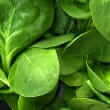Background
- Spinach (Spinacia oleracea) is a good source of iron, folic acid, vitamin B6, nitrates, oxalates, beta-carotene, and lutein. In addition to its food value, spinach has a number of therapeutic uses.
- The German Commission E reports the use of spinach for gastrointestinal disorders, blood-generating therapy, growth stimulation in children, appetite stimulation, convalescent support, and fatigue. Studies have also suggested its use as an anticancer agent, antioxidant, and cancer preventative. Spinach may also reduce age-related eyesight deterioration from macular degeneration and cataracts. More high-quality research is needed.
References
- Berson EL. Nutrition and retinal degenerations. Int Ophthalmol Clin 2000;40(4):93-111. View Abstract
- Blomhoff R. Dietary antioxidants and cardiovascular disease. Curr Opin Lipidol 2005;16(1):47-54. View Abstract
- Chen Z, Ye Z, Zeng L, et al. Clinical investigation on gastric oxalate absorption. Chin Med J (Engl) 2003;116(11):1749-1751. View Abstract
- Chu YF, Sun J, Wu X, et al. Antioxidant and antiproliferative activities of common vegetables. J Agric Food Chem 2002;50(23):6910-6916. View Abstract
- Couris RR, Tataronis GR, Dallal GE, et al. Assessment of healthcare professionals' knowledge about warfarin-vitamin K drug-nutrient interactions. J Am Coll Nutr 2000;19(4):439-445. View Abstract
- Lomnitski L, Bergman M, Nyska A, et al. Composition, efficacy, and safety of spinach extracts. Nutr Cancer 2003;46(2):222-231. View Abstract
- Herrera-Mozo I, Ferrer B, Luis Rodriguez-Sanchez J, et al. Description of a novel panallergen of cross-reactivity between moulds and foods. Immunol Invest 2006;35(2):181-197. View Abstract
- Iijima H, Kasai N, Chiku H, et al. Structure-activity relationship of a glycolipid, sulfoquinovosyl diacylglycerol, with the DNA binding activity of p53. Int J Mol Med 2007;19(1):41-48. View Abstract
- Kopsell DA, Lefsrud MG, Kopsell DE, et al. Spinach cultigen variation for tissue carotenoid concentrations influences human serum carotenoid levels and macular pigment optical density following a 12-week dietary intervention. J Agric Food Chem 2006;54(21):7998-8005. View Abstract
- No authors listed. E. coli O157:H7 outbreak in the United States associated with bagged fresh spinach. Can Commun Dis Rep 2006;32(22):272. View Abstract
- O'Neill ME, Carroll Y, Corridan B, et al. A European carotenoid database to assess carotenoid intakes and its use in a five-country comparative study. Br J Nutr 2001;85(4):499-507. View Abstract
- Savino F, Maccario S, Guidi C, et al. Methemoglobinemia caused by the ingestion of courgette soup given in order to resolve constipation in two formula-fed infants. Ann Nutr Metab 2006;50(4):368-371. View Abstract
- Seddon JM, Ajani UA, Sperduto RD, et al. Dietary carotenoids, vitamins A, C, and E, and advanced age-related macular degeneration. Eye Disease Case-Control Study Group. JAMA 1994;272(18):1413-1420. View Abstract
- Wang R, Furumoto T, Motoyama K, et al. Possible antitumor promoters in Spinacia oleracea (spinach) and comparison of their contents among cultivars. Biosci Biotechnol.Biochem 2002;66(2):248-254. View Abstract
- Wilson RD, Davies G, Desilets V, et al. The use of folic acid for the prevention of neural tube defects and other congenital anomalies. J Obstet Gynaecol Can 2003;25(11):959-973. View Abstract







